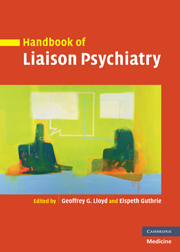Book contents
- Frontmatter
- Contents
- List of contributors
- Preface
- Part I Basic skills
- Part II Common psychiatric problems across the general hospital
- Part III Working with specific units
- 14 Neurological disorders
- 15 Cardiorespiratory disorders
- 16 Gastrointestinal disorders
- 17 Liver disorders
- 18 Endocrine disorders
- 19 Diabetes
- 20 HIV and AIDS
- 21 Renal disease
- 22 Musculo-skeletal disorders
- 23 Oncology
- 24 Head and neck cancer
- 25 Palliative care
- 26 Cosmetic procedures
- 27 Perinatal and gynaecological disorders
- 28 The intensive care unit
- 29 The burns unit
- 30 Psychocutaneous disorders
- 31 Genitourinary disorders
- 32 The emergency department
- Part IV Treatment
- Part V Different treatment settings
- Index
- References
25 - Palliative care
from Part III - Working with specific units
Published online by Cambridge University Press: 10 December 2009
- Frontmatter
- Contents
- List of contributors
- Preface
- Part I Basic skills
- Part II Common psychiatric problems across the general hospital
- Part III Working with specific units
- 14 Neurological disorders
- 15 Cardiorespiratory disorders
- 16 Gastrointestinal disorders
- 17 Liver disorders
- 18 Endocrine disorders
- 19 Diabetes
- 20 HIV and AIDS
- 21 Renal disease
- 22 Musculo-skeletal disorders
- 23 Oncology
- 24 Head and neck cancer
- 25 Palliative care
- 26 Cosmetic procedures
- 27 Perinatal and gynaecological disorders
- 28 The intensive care unit
- 29 The burns unit
- 30 Psychocutaneous disorders
- 31 Genitourinary disorders
- 32 The emergency department
- Part IV Treatment
- Part V Different treatment settings
- Index
- References
Summary
Context
Palliative care arose as a discipline in the 1960s with the birth of the modern hospice movement. From its earliest origins palliative care championed what has come to be known as a ‘patient-centred’ approach to delivering care. In patients with advanced cancer (who remain the core patient group served by most palliative care services) the focus of care was to improve the quality, rather than the duration, of life. Symptom control – especially pain control – was key to this, but also a new approach to patient care in which the need for open and honest communication of diagnosis and prognosis was emphasized. The naïve view that by failing to inform the dying patient of his predicament, the doctor was somehow protecting him from unbearable distress was challenged. Palliative care also emphasizes the familial, social, cultural and spiritual context in which care is provided, and death and its aftermath are managed. Underpinning this is a multidisciplinary approach to the provision of care, with many hospices employing social workers, chaplains, other spiritual advisers, as well as bereavement counsellors, psychiatrists and psychologists.
Hospices are the most obvious means by which palliative care has been developed; however palliative care is not confined to them. The role of hospices is to provide more than terminal care; admissions may take place months or even years before death, in order to bring troublesome symptoms under control.
- Type
- Chapter
- Information
- Handbook of Liaison Psychiatry , pp. 592 - 616Publisher: Cambridge University PressPrint publication year: 2007
References
- 2
- Cited by



